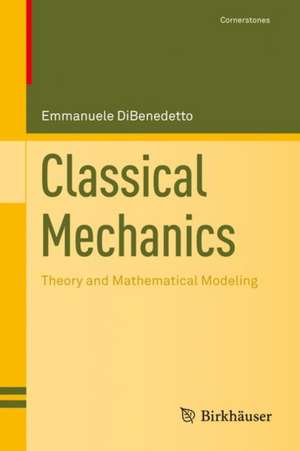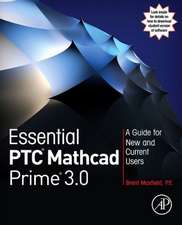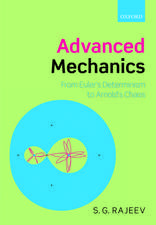Classical Mechanics: Theory and Mathematical Modeling: Cornerstones
Autor Emmanuele DiBenedettoen Limba Engleză Hardback – 26 oct 2010
Din seria Cornerstones
- 18%
 Preț: 857.36 lei
Preț: 857.36 lei - 15%
 Preț: 530.42 lei
Preț: 530.42 lei -
 Preț: 56.07 lei
Preț: 56.07 lei - 15%
 Preț: 590.63 lei
Preț: 590.63 lei - 18%
 Preț: 809.25 lei
Preț: 809.25 lei - 5%
 Preț: 351.06 lei
Preț: 351.06 lei - 5%
 Preț: 351.02 lei
Preț: 351.02 lei - 18%
 Preț: 915.32 lei
Preț: 915.32 lei -
 Preț: 412.19 lei
Preț: 412.19 lei -
 Preț: 453.01 lei
Preț: 453.01 lei - 15%
 Preț: 760.94 lei
Preț: 760.94 lei - 15%
 Preț: 670.64 lei
Preț: 670.64 lei - 15%
 Preț: 598.50 lei
Preț: 598.50 lei - 15%
 Preț: 541.72 lei
Preț: 541.72 lei - 15%
 Preț: 607.01 lei
Preț: 607.01 lei - 15%
 Preț: 647.40 lei
Preț: 647.40 lei - 9%
 Preț: 748.81 lei
Preț: 748.81 lei
Preț: 509.24 lei
Preț vechi: 599.11 lei
-15% Nou
Puncte Express: 764
Preț estimativ în valută:
97.49€ • 101.72$ • 81.72£
97.49€ • 101.72$ • 81.72£
Carte tipărită la comandă
Livrare economică 13-27 martie
Preluare comenzi: 021 569.72.76
Specificații
ISBN-13: 9780817645267
ISBN-10: 0817645268
Pagini: 351
Ilustrații: XX, 351 p. 63 illus.
Dimensiuni: 155 x 235 x 22 mm
Greutate: 0.69 kg
Ediția:2011
Editura: Birkhäuser Boston
Colecția Birkhäuser
Seria Cornerstones
Locul publicării:Boston, MA, United States
ISBN-10: 0817645268
Pagini: 351
Ilustrații: XX, 351 p. 63 illus.
Dimensiuni: 155 x 235 x 22 mm
Greutate: 0.69 kg
Ediția:2011
Editura: Birkhäuser Boston
Colecția Birkhäuser
Seria Cornerstones
Locul publicării:Boston, MA, United States
Public țintă
GraduateCuprins
Preface.- Geometry of Motion.- Constraints and Lagrangian Coordinates.- Dynamics of a Point Mass.- Geometry of Masses.- Systems Dynamics.- The Lagrange Equations.- Precessions.- Variational Principles.- Bibliography.- Index.
Recenzii
From the book reviews:
“This textbook is the outcome of the author’s extensive teaching at the School of Engineering of the University of Rome. It presents the foundations of classical mechanics—from Newton’s laws to Hamilton–Jacobi theory and calculus of variations—using solely the language of vector calculus and linear algebra, however, without sacrificing mathematical rigor. This approach together with the careful and pedagogical nature of the text makes the book, in particular, accessible to students of the applied sciences.” (R. Steinbauer, Monatshefte für Mathematik, Vol. 174, 2014)
“The approach intends to be more mathematical and the choice of subjects will generally appeal more to mathematics and physics students. My overall impression is that the book is strong in its discussion of interesting applications of rigid body mechanics … . Another strong point is the extremely rich collection of historical references in the bibliography.” (Willy Sarlet, SIAM Review, Vol. 54 (3), 2012)
“This work is a beautifully crafted overview of the foundations of classical mechanics … . The text covers the classical topics … and is couched in the language of vector calculus and linear algebra, making it accessible to graduate students in applied mathematics and physics. … A remarkable feature of this book is the extensive bibliography, covering five centuries of mechanics … . the experienced researcher in mechanics will find something new to enjoy in this book.” (Joris Vankerschaver, Mathematical Reviews, Issue 2012 e)
“This volume is based on lectures given by the author on rational mechanics at the University of Rome over a period of more than a decade. The author has developed an approach to the subject that has a distinct flavor and a style of its own. … target audience includes mathematics, physicsand engineering students at advanced undergraduate or beginning graduate level. Each chapter has a ‘Problems and Complements’ section that includes exercises and additional exposition related to the contents of that chapter.” (William J. Satzer, The Mathematical Association of America, April, 2011)
“This textbook is the outcome of the author’s extensive teaching at the School of Engineering of the University of Rome. It presents the foundations of classical mechanics—from Newton’s laws to Hamilton–Jacobi theory and calculus of variations—using solely the language of vector calculus and linear algebra, however, without sacrificing mathematical rigor. This approach together with the careful and pedagogical nature of the text makes the book, in particular, accessible to students of the applied sciences.” (R. Steinbauer, Monatshefte für Mathematik, Vol. 174, 2014)
“The approach intends to be more mathematical and the choice of subjects will generally appeal more to mathematics and physics students. My overall impression is that the book is strong in its discussion of interesting applications of rigid body mechanics … . Another strong point is the extremely rich collection of historical references in the bibliography.” (Willy Sarlet, SIAM Review, Vol. 54 (3), 2012)
“This work is a beautifully crafted overview of the foundations of classical mechanics … . The text covers the classical topics … and is couched in the language of vector calculus and linear algebra, making it accessible to graduate students in applied mathematics and physics. … A remarkable feature of this book is the extensive bibliography, covering five centuries of mechanics … . the experienced researcher in mechanics will find something new to enjoy in this book.” (Joris Vankerschaver, Mathematical Reviews, Issue 2012 e)
“This volume is based on lectures given by the author on rational mechanics at the University of Rome over a period of more than a decade. The author has developed an approach to the subject that has a distinct flavor and a style of its own. … target audience includes mathematics, physicsand engineering students at advanced undergraduate or beginning graduate level. Each chapter has a ‘Problems and Complements’ section that includes exercises and additional exposition related to the contents of that chapter.” (William J. Satzer, The Mathematical Association of America, April, 2011)
Textul de pe ultima copertă
Classical mechanics is a chief example of the scientific method organizing a "complex" collection of information into theoretically rigorous, unifying principles; in this sense, mechanics represents one of the highest forms of mathematical modeling. This textbook covers standard topics of a mechanics course, namely, the mechanics of rigid bodies, Lagrangian and Hamiltonian formalism, stability and small oscillations, an introduction to celestial mechanics, and Hamilton–Jacobi theory, but at the same time features unique examples—such as the spinning top including friction and gyroscopic compass—seldom appearing in this context. In addition, variational principles like Lagrangian and Hamiltonian dynamics are treated in great detail.
Using a pedagogical approach, the author covers many topics that are gradually developed and motivated by classical examples. Through `Problems and Complements' sections at the end of each chapter, the work presents various questions in an extended presentation that is extremely useful for an interdisciplinary audience trying to master the subject. Beautiful illustrations, unique examples, and useful remarks are key features throughout the text.
Classical Mechanics: Theory and Mathematical Modeling may serve as a textbook for advanced graduate students in mathematics, physics, engineering, and the natural sciences, as well as an excellent reference or self-study guide for applied mathematicians and mathematical physicists. Prerequisites include a working knowledge of linear algebra, multivariate calculus, the basic theory of ordinary differential equations, and elementary physics.
Using a pedagogical approach, the author covers many topics that are gradually developed and motivated by classical examples. Through `Problems and Complements' sections at the end of each chapter, the work presents various questions in an extended presentation that is extremely useful for an interdisciplinary audience trying to master the subject. Beautiful illustrations, unique examples, and useful remarks are key features throughout the text.
Classical Mechanics: Theory and Mathematical Modeling may serve as a textbook for advanced graduate students in mathematics, physics, engineering, and the natural sciences, as well as an excellent reference or self-study guide for applied mathematicians and mathematical physicists. Prerequisites include a working knowledge of linear algebra, multivariate calculus, the basic theory of ordinary differential equations, and elementary physics.
Caracteristici
Offers a rigorous mathematical treatment of mechanics as a text or reference Revisits beautiful classical material, including gyroscopes, precessions, spinning tops, effects of rotation of the Earth on gravity motions, and variational principles Employs mathematics not only as a "unifying" language, but also to exemplify its role as a catalyst behind new concepts and discoveries Includes supplementary material: sn.pub/extras











